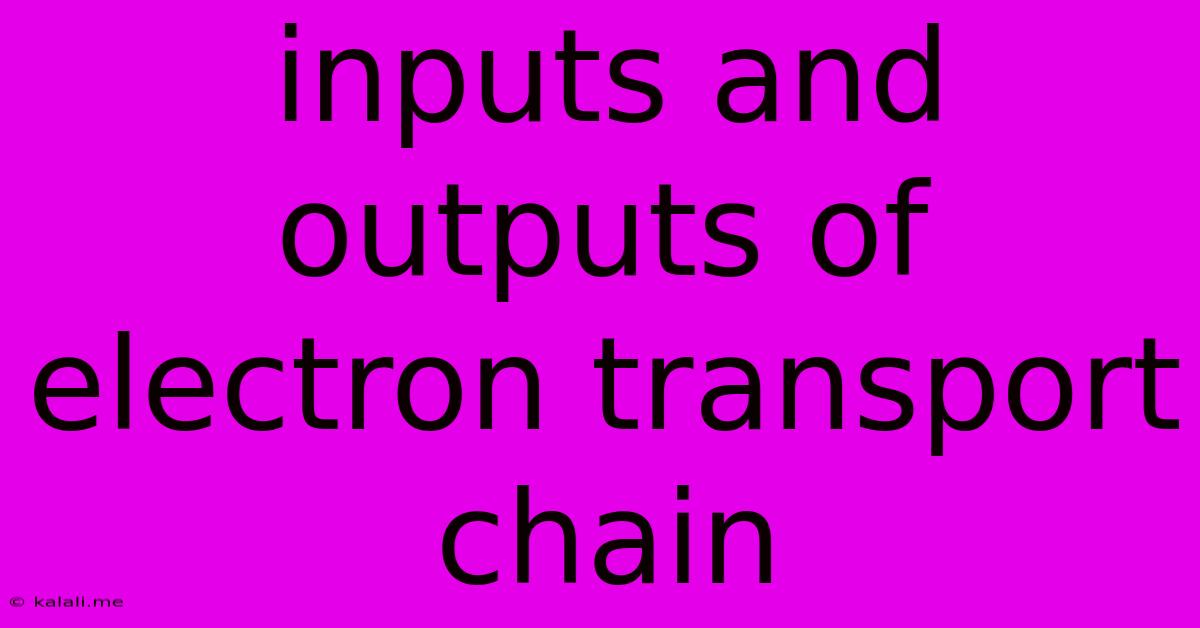Inputs And Outputs Of Electron Transport Chain
Kalali
May 08, 2025 · 3 min read

Table of Contents
Inputs and Outputs of the Electron Transport Chain: A Comprehensive Guide
The electron transport chain (ETC), also known as the respiratory chain, is a series of protein complexes embedded in the inner mitochondrial membrane of eukaryotic cells and the plasma membrane of prokaryotes. It plays a crucial role in cellular respiration, the process that generates the majority of ATP, the cell's primary energy currency. Understanding its inputs and outputs is key to grasping its vital function. This article will delve into the specifics of what goes into and what comes out of this essential biological process.
What are the Inputs of the Electron Transport Chain?
The ETC's primary function is to harness the energy stored in high-energy electrons to pump protons (H+) across the inner mitochondrial membrane. These high-energy electrons are the crucial input, originating from two main sources:
-
NADH: Nicotinamide adenine dinucleotide (NADH) is a coenzyme produced during glycolysis and the citric acid cycle (Krebs cycle). It carries two high-energy electrons and a proton (H+), effectively donating three protons to the ETC during oxidation. These electrons enter the ETC at Complex I (NADH dehydrogenase).
-
FADH2: Flavin adenine dinucleotide (FADH2), another coenzyme produced during the citric acid cycle, also carries high-energy electrons. However, FADH2 enters the ETC at Complex II (succinate dehydrogenase), contributing fewer protons to the proton gradient compared to NADH. This results in less ATP production from FADH2 than from NADH.
-
Oxygen (O2): Although not an electron carrier, oxygen serves as the final electron acceptor in the ETC. Without oxygen, the electron transport chain would cease to function, leading to a significant reduction in ATP production. This explains why aerobic respiration is so much more efficient than anaerobic respiration.
What are the Outputs of the Electron Transport Chain?
The ETC's output is multifaceted, primarily involving the generation of a proton gradient and the production of water:
-
Proton Gradient (Proton Motive Force): As electrons move down the ETC, energy is released and used by protein complexes I, III, and IV to pump protons (H+) from the mitochondrial matrix across the inner mitochondrial membrane into the intermembrane space. This creates a proton gradient, a difference in both proton concentration and electrical charge across the membrane. This gradient stores potential energy.
-
ATP Synthesis: The proton gradient drives ATP synthesis via chemiosmosis. Protons flow back into the matrix through ATP synthase, an enzyme that utilizes the energy of the proton flow to phosphorylate ADP to ATP. This is oxidative phosphorylation, the major ATP-producing process in cellular respiration. The exact ATP yield varies depending on the shuttle system used to transport NADH from glycolysis into the mitochondria.
-
Water (H2O): At the end of the electron transport chain, the electrons are ultimately transferred to oxygen, which combines with protons (H+) to form water. This is a crucial step, ensuring that the electron carriers remain oxidized and ready to accept more electrons.
In summary:
The electron transport chain takes in high-energy electrons from NADH and FADH2, utilizes oxygen as the final electron acceptor, and produces a proton gradient that drives ATP synthesis via chemiosmosis and generates water as a byproduct. This intricate process is vital for efficient energy production within cells. Disruptions to any component of the ETC can have significant consequences for cellular function and overall health.
Latest Posts
Latest Posts
-
A Force That Opposes The Motion Of An Object
May 08, 2025
-
What Percent Of 32 Is 8
May 08, 2025
-
Which Graph Represents An Exponential Decay Function
May 08, 2025
-
40 Is What Percent Of 80
May 08, 2025
-
How To Convert Moles Into Mass
May 08, 2025
Related Post
Thank you for visiting our website which covers about Inputs And Outputs Of Electron Transport Chain . We hope the information provided has been useful to you. Feel free to contact us if you have any questions or need further assistance. See you next time and don't miss to bookmark.